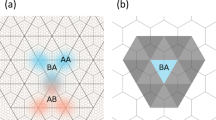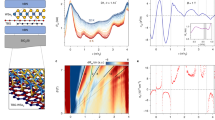Abstract
Geometric frustration occurs in a lattice system when not all the interactions can be satisfied simultaneously. The simplest example is antiferromagnetically coupled spins on a triangular lattice. Frustrated systems are characterized by having many nearly degenerate ground states, leading to non-trivial phases, such as spin ice and spin liquids. To date, most studies have looked at geometric frustration of spins whereas orbital geometric frustration has been much less explored. For electrons in twisted bilayer graphene, when the electronic bands are filled to a fraction with denominator 3, Coulomb interactions and the Wannier orbital shapes are predicted to strongly constrain spatial charge ordering, leading to geometrically frustrated ground states that produce a new class of correlated insulating states. Here we report the observation of dominant, denominator 3, fractional-filling, insulating states in large-angle twisted bilayer graphene. These states persist in magnetic fields and display magnetic ordering signatures and tripled unit cell reconstruction. These results are in agreement with a strong-coupling theory for symmetry-breaking in geometrically frustrated fractional states.
This is a preview of subscription content, access via your institution
Access options
Access Nature and 54 other Nature Portfolio journals
Get Nature+, our best-value online-access subscription
$32.99 / 30 days
cancel any time
Subscribe to this journal
Receive 12 print issues and online access
$259.00 per year
only $21.58 per issue
Buy this article
- Purchase on SpringerLink
- Instant access to full article PDF
Prices may be subject to local taxes which are calculated during checkout




Similar content being viewed by others
Data availability
Source data are provided with this paper. The data that support the findings of this study are available from the corresponding authors on reasonable request.
Code availability
The code that supports the findings of this study is available from the corresponding authors upon reasonable request.
References
Cao, Y. et al. Correlated insulator behaviour at half-filling in magic-angle graphene superlattices. Nature 556, 80–84 (2018).
Padhi, B., Setty, C. & Phillips, P. W. Doped twisted bilayer graphene near magic angles: proximity to Wigner crystallization, not Mott insulation. Nano Lett. 18, 6175–6180 (2018).
Padhi, B. & Phillips, P. W. Pressure-induced metal-insulator transition in twisted bilayer graphene. Phys. Rev. B 99, 205141 (2019).
Regan, E. C. et al. Mott and generalized Wigner crystal states in WSe2/WS2 moiré superlattices. Nature 579, 359–363 (2020).
Xu, Y. et al. Correlated insulating states at fractional fillings of moiré superlattices. Nature 587, 214–218 (2020).
Li, H. et al. Imaging two-dimensional generalized Wigner crystals. Nature 597, 650–654 (2021).
Padhi, B., Chitra, R. & Phillips, P. W. Generalized Wigner crystallization in moiré materials. Phys. Rev. B 103, 125146 (2021).
Zhang, K., Zhang, Y., Fu, L. & Kim, E.-A. Fractional correlated insulating states at one-third filled magic-angle twisted bilayer graphene. Commun. Phys. 5, 250 (2022).
Zhou, Y. et al. Bilayer Wigner crystals in a transition metal dichalcogenide heterostructure. Nature 595, 48–52 (2021).
Lau, C. N., Bockrath, M. W., Mak, K. F. & Zhang, F. Reproducibility in the fabrication and physics of moiré materials. Nature 602, 41–50 (2022).
Streda, P. Quantised Hall effect in a two-dimensional periodic potential. J. Phys. C 15, L1299 (1982).
MacDonald, A. Landau-level subband structure of electrons on a square lattice. Phys. Rev. B 28, 6713 (1983).
Spanton, E. M. et al. Observation of fractional Chern insulators in a van der Waals heterostructure. Science 360, 62–66 (2018).
Cheng, B. et al. Fractional and symmetry-broken Chern insulators in tunable moiré superlattices. Nano Lett. 19, 4321–4326 (2019).
Xie, Y. et al. Fractional Chern insulators in magic-angle twisted bilayer graphene. Nature 600, 439–443 (2021).
Rickhaus, P. et al. Correlated electron-hole state in twisted double-bilayer graphene. Science 373, 1257–1260 (2021).
Li, Q. et al. Tunable quantum criticalities in an isospin extended Hubbard model simulator. Nature 609, 479–484 (2022).
Shen, C. et al. Dirac spectroscopy of strongly correlated phases in twisted trilayer graphene. Nat. Mater. 22, 316–321 (2023).
Mao, D., Zhang, K. & Kim, E.-A. Fractionalization in fractional correlated insulating states at n ±1/3 filled twisted bilayer graphene. Phys. Rev. Lett. 131, 106801 (2023).
Kang, J. & Vafek, O. Symmetry, maximally localized Wannier states, and a low-energy model for twisted bilayer graphene narrow bands. Phys. Rev. X 8, 031088 (2018).
Koshino, M. et al. Maximally localized Wannier orbitals and the extended Hubbard model for twisted bilayer graphene. Phys. Rev. X 8, 031087 (2018).
Po, H. C., Zou, L., Vishwanath, A. & Senthil, T. Origin of Mott insulating behavior and superconductivity in twisted bilayer graphene. Phys. Rev. 8, 031089 (2018).
Marzari, N., Mostofi, A. A., Yates, J. R., Souza, I. & Vanderbilt, D. Maximally localized Wannier functions: theory and applications. Rev. Mod. Phys. 84, 1419 (2012).
Lu, X. et al. Superconductors, orbital magnets, and correlated states in magic-angle bilayer graphene. Nature 574, 653–657 (2019).
Yankowitz, M. et al. Tuning superconductivity in twisted bilayer graphene. Science 363, 1059–1064 (2019).
Tian, H. et al. Evidence for Dirac flat band superconductivity enabled by quantum geometry. Nature 614, 440–444 (2023).
Codecido, E. et al. Correlated insulating and superconducting states in twisted bilayer graphene below the magic angle. Sci. Adv. 5, eaaw9770 (2019).
Balents, L., Dean, C. R., Efetov, D. K. & Young, A. F. Superconductivity and strong correlations in moiré flat bands. Nat. Phys. 16, 725–733 (2020).
Zondiner, U. et al. Cascade of phase transitions and Dirac revivals in magic-angle graphene. Nature 582, 203–208 (2020).
Saito, Y. et al. Hofstadter subband ferromagnetism and symmetry-broken Chern insulators in twisted bilayer graphene. Nat. Phys. 17, 478–481 (2021).
Stepanov, P. et al. Competing zero-field Chern insulators in superconducting twisted bilayer graphene. Phys. Rev. Lett. 127, 197701 (2021).
Nuckolls, K. P. et al. Strongly correlated Chern insulators in magic-angle twisted bilayer graphene. Nature 588, 610–615 (2020).
Choi, Y. et al. Correlation-driven topological phases in magic-angle twisted bilayer graphene. Nature 589, 536–541 (2021).
Wu, S., Zhang, Z., Watanabe, K., Taniguchi, T. & Andrei, E. Y. Chern insulators, van Hove singularities and topological flat bands in magic-angle twisted bilayer graphene. Nat. Mater. 20, 488–494 (2021).
Das, I. et al. Symmetry-broken Chern insulators and Rashba-like Landau-level crossings in magic-angle bilayer graphene. Nat. Phys. 17, 710–714 (2021).
Krishna Kumar, R. et al. High-temperature quantum oscillations caused by recurring Bloch states in graphene superlattices. Science 357, 181–184 (2017).
Acknowledgements
We thank F. Zhang for helpful discussions. The experiments were supported by the Basic Energy Sciences division of the Department of Energy (Grant No. DE-SC0020187). Devices were fabricated using a nanofabrication facility supported by the Materials Research Science and Engineering Center of the National Science Foundation (NSF; Grant No. DMR-2011876). D.M. and E-A.K. are supported by the Gordon and Betty Moore Foundation’s EPiQS Initiative (Grant No. GBMF10436). K.Z. is supported by the NSF (Grant No. EAGER OSP-136036) and the Natural Sciences and Engineering Research Council of Canada (Grant No. PGS-D-557580-2021). E.-A.K. acknowledges support from the Ewha Frontier 10-10 Research Grant and the Simons Fellowship in Theoretical Physics (Award 920665). A portion of this work was performed at the National High Magnetic Field Laboratory, which is supported by the NSF (Grant No. NSF/DMR-1644779) and the State of Florida. K.W. and T.T. acknowledge support from the JSPS KAKENHI (Grant Nos. 21H05233 and 23H02052) and World Premier International Research Center Initiative, MEXT, Japan.
Author information
Authors and Affiliations
Contributions
C.N.L. and M.B. conceived the project. H.T. and E.C. fabricated devices with assistance from S.C. H.T., E.C. and D.S. performed the measurements. K.W. and T.T. provided the hBN crystals. D.M. and K.Z. performed the theoretical calculations under the supervision of E.-A.K. C.N.L and M.B. analysed the data. C.N.L., M.B., E.-A.K. and D.M. interpreted the data and wrote the paper. All authors read and commented on the paper.
Corresponding authors
Ethics declarations
Competing interests
The authors declare no competing interests.
Peer review
Peer review information
Nature Physics thanks the anonymous reviewers for their contribution to the peer review of this work.
Additional information
Publisher’s note Springer Nature remains neutral with regard to jurisdictional claims in published maps and institutional affiliations.
Supplementary information
Supplementary Information
Supplementary Figs. 1–10, Discussion A–E and Tables 1–5.
Source data
Source Data Fig. 1
Statistical source data
Source Data Fig. 2
Statistical source data
Source Data Fig. 3
Statistical source data
Source Data Fig. 4
Statistical source data
Rights and permissions
Springer Nature or its licensor (e.g. a society or other partner) holds exclusive rights to this article under a publishing agreement with the author(s) or other rightsholder(s); author self-archiving of the accepted manuscript version of this article is solely governed by the terms of such publishing agreement and applicable law.
About this article
Cite this article
Tian, H., Codecido, E., Mao, D. et al. Dominant 1/3-filling correlated insulator states and orbital geometric frustration in twisted bilayer graphene. Nat. Phys. 20, 1407–1412 (2024). https://doi.org/10.1038/s41567-024-02546-5
Received:
Accepted:
Published:
Issue date:
DOI: https://doi.org/10.1038/s41567-024-02546-5
This article is cited by
-
Bionic fractionalization in the trimer model of twisted bilayer graphene
Communications Materials (2025)



